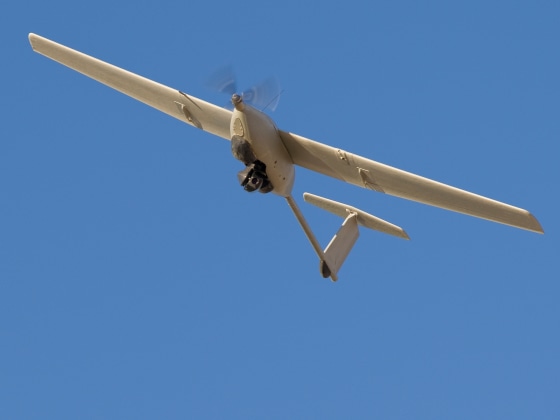LaserMotive has demonstrated a power system that can keep Lockheed Martin's Stalker unmanned aerial vehicle going for more than 48 hours with laser light — but that's not the most amazing part. What's even more amazing is that the drone could have stayed in operation basically indefinitely, feeding off those frickin' laser beams.
"We've demonstrated to ourselves, and to our partners, that the technology works," LaserMotive President Tom Nugent told me last night. "Our Lockheed Martin Skunk Works partners realize how valuable wireless power via laser will be to the future of aerospace."
Nugent said the June 25-27 test, conducted at LaserMotive's headquarters facility in Kent, Wash., was done with the Stalker mounted inside a wind tunnel. But it won't be long before the kind of laser-beaming power that Dr. Evil could only dream about will be put to the test under real-world conditions.
"We will be taking it out of the wind tunnel very soon," said Melissa Dalton, a spokeswoman for Lockheed Martin.
The Stalker is a camera-equipped, hand-launched unmanned aerial system that's been used by U.S. Special Operations Forces since 2006 to perform intelligence, surveillance and reconnaissance missions. It's also been tested for domestic applications such as border patrol and pipeline surveillance.
One of the craft's limitations has to do with how much time it can spend aloft. A battery-powered Stalker can stay up for more than two hours, and last year a Pentagon-funded project used propane-powered fuel cells to extend that hang time to eight-plus hours. But that's nothing compared to the laser system. During the test, laser beams sent energy over a distance of about 30 feet (9 meters) to a photovoltaic receiver on the Stalker. That energy was then converted into electricity to power the Stalker. At the end of the two-day test, the Stalker's batteries carried more of a charge than they did when the test began, Lockheed Martin said in a news release.
"We're pleased with the results of this test," said Tom Koonce, Stalker program manager at the Skunk Works. "Laser power holds real promise in extending the capabilities of Stalker. A ground-to-air recharging system like this allows us to provide practically unlimited flight endurance to extend and expand the mission profiles that the Stalker vehicle can fulfill."
Nugent said wireless power transmission via laser is a good way to keep devices like the Stalker going for days at a time — in fact, it may be the only way.
He expects that the real-world aerial testing will be done over a military base or range that offers controlled airspace. In some circumstances, it can be a challenge to send a laser beam through the atmosphere for long distances, particularly during inclement weather, but "over the ranges we're talking about, atmospherics are not an issue," Nugent said.
LaserMotive made its first big splash in 2009 when its laser-powered robo-climber won a $900,000 prize in NASA's Space Elevator Games.
"Since the NASA competition, we have viewed UAVs as the most compelling first application of wireless power transmission," Nugent said. He declined to say how much LaserMotive was being paid for its work on the Stalker, but he said he expected progress to come rapidly in the wake of last month's wind-tunnel test.
"We think it's basically a one-year process to get this to a field-ready system," Nugent said. "It's something that could be fielded in the next year."
We already have sharks with frickin' laser beams, to quote Dr. Evil, and now we're going to have laser-powered robo-planes. What's next? Feel free to share your high-tech dreams or nightmares in the comment space below.
More on laser power:
- Copter sets a laser-powered record
- Laser beams can beam power to drones
- Super-laser fully operational at last
- 10 strange and dangerous uses for lasers
Alan Boyle is msnbc.com's science editor. Connect with the Cosmic Log community by "liking" the log's Facebook page, following @b0yle on Twitter and adding the Cosmic Log page to your Google+ presence. You can also check out "The Case for Pluto," my book about the controversial dwarf planet and the search for new worlds.
